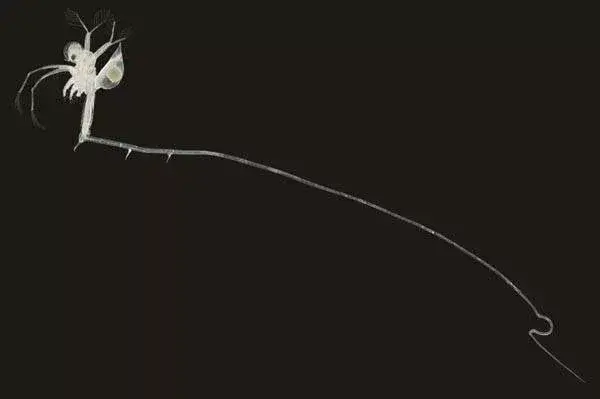
Cercopagis pengoi, known in North America as the “fishhook water flea,” is an aggressive, predatory zooplankton that preys on smaller zooplankton. It belongs to the same family as Bythotrephes (Cercopagididae), and, like Bythotrephes, has a long caudal process (“tail”) with up to three pairs of barbs near its end. Also like Bythotrephes, Cercopagis is a native of the Ponto-Caspian region of eastern Europe/western Asia (the area of the Caspian, Azov, and Aral seas). As with the spiny water flea, the fishhook water flea is believed to be an international shipping ballast water introduction.
Since its first discovery in Lake Ontario in August 1998, copagis spread inland to six of New York’s Finger Lakes (Seneca, Cayuga, Otisco, Canandaigua, Owasco and Keuka) within a year, possibly on fishery sampling gear, in bait buckets, or on recreational angling equipment. In these inland lakes, Cercopagis now dominates the offshore zooplankton community during the summer and fall. This species has also been found in Grand Traverse Bay and southern Lake Michigan and in western Lake Erie and the Detroit River. It is expected to spread throughout the Great Lakes by means of currents, inter- and intra-lake ballast transfers and recreational boating and angling. The fishhook water flea, like the spiny water flea, fouls fishing lines, downs rigger cables and fish nets, in many cases to an extent that anglers have had to cut their lines and lose fish because of reel clogging. The species’ length, including body and spine, can exceed 1 cm.
The species has been observed at densities of 170 to 600 individuals per square meter. In addition to sexual reproduction, Cercopagis most commonly reproduce parthenogenically (asexually), which allows them to quickly establish new populations with a relatively small seed population without the need for a large number of the smaller males along with females. Eggs produced in the early part of the season are delicate and very susceptible to damage, with low recruitment rates. Later in the season, as surface water temperatures decline, Cercopagis females produce over-wintering or resting eggs (the species is also known to produce resting eggs anytime during the year when environmental conditions become inhospitable). Such resting eggs can successfully overwinter in an inactive state and replenish the population after hatching in the spring. Resting eggs are also resistant to desiccation, freeze-drying and ingestion by predators (such as other fish). They can be easily transported to other drainage basins by various vectors, particularly if they are still in the female’s body (the barbed caudal spine allows attachment to ropes, fishing lines, waterfowl feathers, aquatic gear, vegetation, and mud). Resting eggs can hatch regardless of whether the carrier female is alive or dead.
It is unknown what the future impacts of Cercopagis are going to be. It is possible that the high population densities of the species will create significant predation pressure on smaller cladocerans to impact the size and composition of native phytoplankton communities. Furthermore, Cercopagis may compete with native, young-of-the-year fish populations for small prey. It is also possible that the species may become prey itself for larger fish. It is not known, therefore, whether Cercopagis will ultimately be an energetic source or sink in the Great Lakes.
